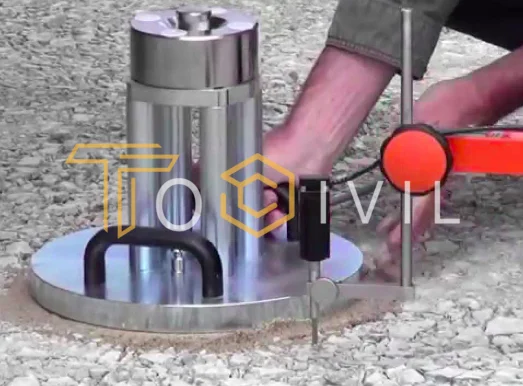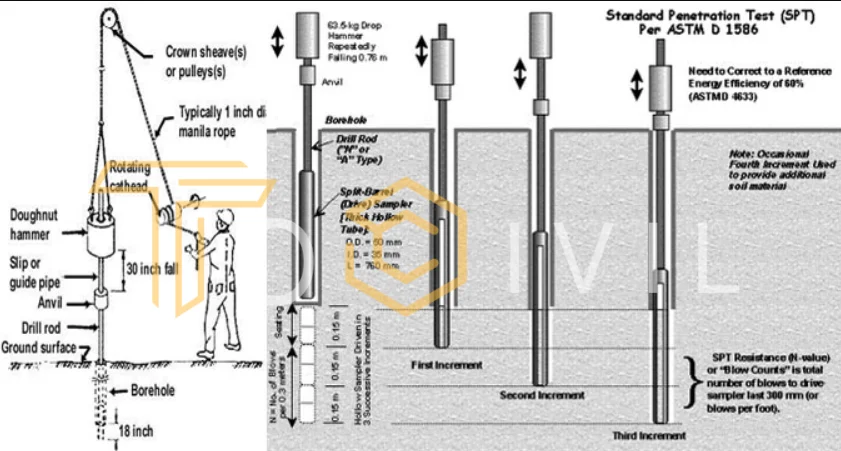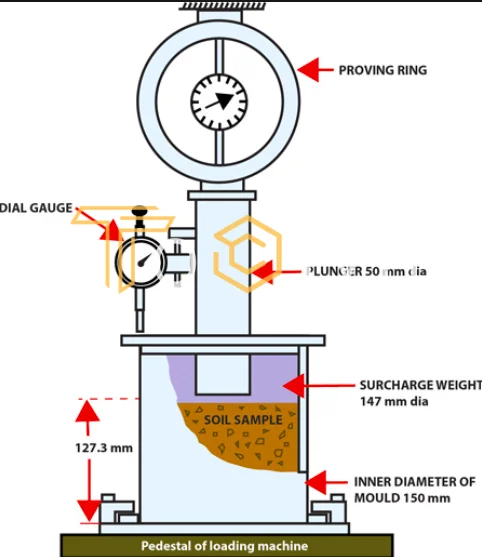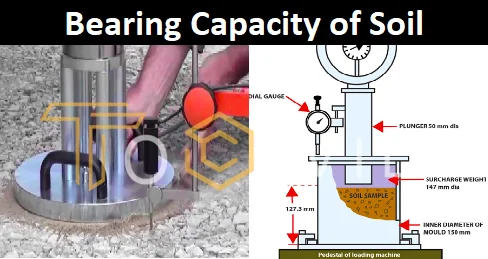Bearing Capacity of Soil
“The bearing capacity of soil refers to the maximum load that can be applied to the soil without causing a shear failure or excessive foundation settlement. In other words, the soil can support a structure’s or foundation’s weight without collapsing or settling beyond acceptable limits”.
- All civil engineering structures, including buildings, dams, bridges, and others, are constructed on the soil. A foundation is necessary to transfer the structure’s weight over a considerable area of the earth. The structure’s foundation should be built to prevent excessive settlement of the building and soil failure in the shear below. The idea of bearing capacity is the foundation for the traditional foundation design process.
- When under stress from loading, the soil tends to deform. The soil’s resistance to deformation is influenced by water content, bulk density, angle of internal friction, and how a force is applied to it. The bearing capacity of soils directs to the most critical load per unit area that the soil or rock can support without yielding or displacement.
- Soil characteristics, including shear strength, density, permeability, and others, influence the carrying capacity of the soil. Because thick sand has a higher unit weight than loose sand, it will have a greater bearing capacity.
- A shallow foundation is supplied if the soil’s shallow depth-bearing capacity is sufficient to safely support the structure’s weight. The options for the shallow foundation include isolated footing, combination footing, and strip footing. Deep foundations are installed when the earth immediately beneath a structure lacks bearing capacity. For deep foundations, there are three options: piers, piles, or wells. For soil that experiences differential settlement or where there is a significant difference in loading between neighboring columns, mat or raft foundations are beneficial.
Loam Soil
For most garden plants, Loam defines the optimal soil composition; nevertheless, certain plants prefer sandy, rocky, or clay soil. To prevent plant roots from sitting in water and rotting, Loam holds nutrients and has a texture that maintains moisture long enough for plant roots to access it. Loam also drains efficiently. Plants struggle to live in poor soil and typically need additional feeding and watering.
- Farmers, gardeners, and homeowners highly desire Loam because it is excellent for growing various plants, including grass, trees, shrubs, fruits, and flowers.
- The medium-textured loam soil that plants grow in allows air to circulate the roots of the plants, protecting them from illnesses frequently seen in compacted, poorly draining soils.
- Because of the soil’s roughness, roots may spread out quickly, hold onto moisture, and absorb nutrients.
- Topsoil combined with organic matter to hold moisture and nutrients can create good loam soil.
- Before seeding or transplanting, test the soil for pH, nutrients, and organic matter. Add lime, fertilizer, and organic matter as needed to meet the optimal requirements of your specific plant.
- Tests make sure you provide your plants with the right conditions for germination, successful potting or repotting, and healthy growth.
Clay Soil
Amazingly, clay particles predominate in soil. The relative sizes of the various soil particles (clay, sand, and silt) account for this. Because of their small size, clay particles can pack more of them into a given area (let’s say 1 cm cubed), giving them a large surface area that dominates the physical characteristics of the soil. Sand and silt particles, in contrast, are more significant. Therefore, fewer are required to cover a space completely (say 1 cm cubed again). As a result, sand and silt have a smaller overall surface area compared to clay particles and are, therefore, less influential in influencing soil properties.
Types of Bearing Capacity of Soil
Ultimate bearing capacity (qu)
The soil’s ultimate bearing capacity (qu) is the maximum load per unit area the earth can withstand before failure occurs, such as excessive settlement, shear loss, or other forms of instability. The ultimate bearing capacity is affected by various factors such as the soil type, its shear strength, drainage conditions, the shape and size of the foundation, and the load duration. The ultimate bearing capacity is typically determined through field tests or laboratory experiments.
Net ultimate bearing capacity (qnu)
The net ultimate bearing capacity of soil refers to the ultimate bearing capacity reduced by the weight of the soil column above the failure surface. It is the maximum load per unit area that the soil can support after considering the self-weight of the soil above the failure surface. The net ultimate bearing capacity is a critical factor in the design and construction of shallow foundations for structures where the foundation is close to the ground surface, and the soil layers above the foundation contribute significantly to the load-carrying capacity. The calculation of net ultimate bearing capacity involves the consideration of the soil strength, soil properties, and load duration, typically determined through field tests or laboratory experiments.
We shall obtain net ultimate bearing capacity by subtracting the overburden pressure from ultimate bearing capacity.
qnu = qn – rDf
Where r is unit weight of soil & Df is depth of foundation
Net safe bearing capacity (qns)
The net safe bearing capacity of soil refers to the maximum load per unit area that the soil can safely support without causing excessive settlement or shear failure after considering the self-weight of the soil above the failure surface. It is the ultimate bearing capacity of the soil reduced by a factor of safety to account for uncertainties in soil strength and other factors affecting the load-carrying capacity of the soil.
The net safe bearing capacity is a critical factor in designing and constructing shallow foundations for buildings, bridges, and other structures to ensure their safety and stability under various loading conditions. The calculation of net safe bearing capacity involves the consideration of soil properties, soil strength, and load duration, typically determined through field tests or laboratory experiments. It is commonly used in geotechnical engineering design.
The net safe bearing capacity is obtained by dividing the net ultimate bearing capacity by a specific safety factor while solely taking into account shear failure.
qns = qnu/ F
Where F is factor of safety
Gross safe bearing capacity (qs)
The gross safe bearing capacity (qs) of soil refers to the maximum load per unit area that the soil can safely support without causing excessive settlement or shear failure, without considering the weight of the soil column above the failure surface. It is the ultimate bearing capacity of the soil reduced by a factor of safety to account for uncertainties in soil strength and other factors affecting the load-carrying capacity of the soil.
The gross safe bearing capacity is a critical factor in designing and constructing shallow foundations for buildings, bridges, and other structures to ensure their safety and stability under various loading conditions. The calculation of gross safe bearing capacity involves the consideration of soil properties, soil strength, and load duration, typically determined through field tests or laboratory experiments. It is commonly used in geotechnical engineering design.
Gross safe bearing capacity is obtained by dividing ultimate carrying capacity by the factor of safety.
qs = qu/F
Net safe settlement pressure (qnp)
Net safe settlement pressure is the amount of pressure that a given amount of soil can support without exceeding the permitted settlement.
OR
The net safe settlement pressure of soil refers to the maximum load per unit area the soil can safely support without causing excessive settlement or differential settlement of the foundation. It is the soil’s safe bearing capacity reduced by the foundation’s weight and divided by a settlement factor to ensure that the foundation does not experience excessive settlement.
The net safe settlement pressure is a critical factor in designing and constructing shallow foundations for buildings, bridges, and other structures to ensure their safety and stability under various loading conditions. The calculation of net safe settlement pressure involves the consideration of soil properties, soil strength, the weight of the foundation, and the settlement factor, and it is typically determined through field tests or laboratory experiments. It is commonly used in geotechnical engineering design.
Net allowable bearing pressure (qna)
The net allowable bearing pressure of soil refers to the maximum load per unit area that the soil can safely support without causing excessive settlement or shear failure after considering the self-weight of the soil column located above the failure surface and applying a safety factor to the net ultimate bearing capacity. It is the maximum allowable load-carrying capacity of the soil for a particular design and safety factor.
The net permissible bearing pressure is a critical factor in designing and constructing shallow foundations for buildings, bridges, and other structures to ensure their safety and stability under various loading conditions. Calculating net allowable bearing pressure involves the consideration of soil properties, soil strength, the weight of the soil and foundation above the failure surface, the load duration, and the safety factor. It is typically determined through field tests or laboratory experiments. It is commonly used in geotechnical engineering design.
We may use this pressure to design the foundations. If qnp > qns, then this is equivalent to net safe bearing pressure. It is equal to net safe settlement pressure in the opposite case.
Methods of Calculation
There are several methods available for calculating the bearing capacity of soil which are as follows.
Plate Bearing Test
The Plate Bearing Test is a field test used to determine soil’s bearing capacity and settlement under a specific loading condition. The test involves loading a circular plate of known diameter onto the soil surface and measuring the resulting deformation. Here are the details of the Plate Bearing Test:

Equipment
The Plate Bearing Test equipment consists of a circular steel plate, a loading frame, a hydraulic jack, and a set of dial gauges to measure the deformation of the soil surface.
Test procedure
A 300 mm or 450 mm diameter circular plate is placed on the soil surface at the test location. A hydraulic jack is used to apply a vertical load to the plate, and the resulting deformation of the soil surface is measured using dial gauges placed around the plate.
Load increments
The load is applied in increments, with each increment maintained for a certain period to allow the soil to consolidate. The loading is continued until the plate reaches a certain settlement or the desired load.
Calculation of bearing capacity
The bearing capacity of the soil is calculated based on the maximum load the plate can support without exceeding specified settlement criteria. The bearing capacity is calculated using the following equation:
q = P/A
where q is the bearing capacity (kN/m2), P is the maximum load (kN), and A is the area of the plate (m2).
Unconfined Compression Test
The unconfined compression test is a laboratory test used to determine the strength of a cohesive soil sample without any lateral confinement. This test is widely used to design shallow foundations, analyze slope stability, and evaluate soil strength parameters. Here are the details of the unconfined compression test:

Sample preparation
The sample for the test is prepared by trimming the soil sample to remove any irregularities, and then the ends of the model are smoothed using a planer. The height-to-diameter ratio of the sample should be between 2:1 and 3:1 to ensure proper failure.
Testing apparatus
The unconfined compression test apparatus consists of a loading frame and a piston assembly. The loading frame applies a vertical load to the piston, compressing the soil sample. The rate of loading is usually between 0.5 and 2 mm/min.
Test procedure
The prepared soil sample is placed in the loading frame, and the piston is lowered onto the top of the sample. The piston is then raised to a specific height to ensure proper contact between the piston and the sample. The test is then conducted by applying a vertical load on the sample at a constant rate until failure occurs.
Failure criteria
Failure occurs when the soil sample reaches its maximum stress or when the soil sample undergoes a significant amount of deformation. The maximum stress is calculated by dividing the load at failure by the cross-sectional area of the sample.
Test results
The unconfined compression test provides two important parameters: the unconfined compressive strength (UCS) and the stress-strain relationship of the soil sample. The UCS is the maximum stress the soil sample can withstand without lateral confinement. The stress-strain relationship provides information about the deformation characteristics of the soil.
Standard Penetration Test
The Standard Penetration Test is a used field test in geotechnical engineering to specify the soil’s resistance to penetration. In order to perform the test, a standard sampler must be hammered into the soil. The number of blows necessary to bury the sampler to a specific depth must be recorded. Here are the details of the Standard Penetration Test:

Equipment
The SPT equipment consists of a split-barrel sampler, a drive head, drill rods, and a hammer. The hammer weighs between 63.5 and 76 kg and is dropped from a height of 75 cm.
Test procedure
A borehole is drilled to the selected depth using a drill rig and the sampler is inserted into the borehole. The hammer is lifted and allowed to fall onto the drive head, which drives the sampler into the soil. The number of blows required to drive the sampler to a certain depth is recorded.
Sampler
The sampler is a split-barrel type, which consists of a tube split into two halves that can be separated to remove the soil sample. The sampler is usually 50 mm in diameter and 300 mm long, with a thin cutting edge on the bottom to aid penetration.
Test depth
The SPT test is typically performed at 1.5 m intervals along the borehole. The test is continued until the required depth is reached or until the number of blows per 150 mm penetration decreases to a specific value.
Test results
The SPT test provides two important parameters: the number of blows required to drive the sampler to a certain depth (N-value) and the soil classification based on the N-value. The N-value is used to determine the soil’s strength, while the soil classification is used to evaluate the soil’s properties and behavior.
California Bearing Ratio Test
The California Bearing Ratio (CBR) Test is a laboratory test to determine the strength of soil and its bearing capacity. The test is widely used in the design of flexible pavements, airport runways, and other transportation infrastructure. Here are the details of the California Bearing Ratio Test:

Sample preparation
The sample for the CBR test is prepared by compacting the soil sample into a mold with a diameter of 150 mm and a height of 127 mm. The sample is compacted at different moisture content and density levels to represent the field conditions.
Testing apparatus
The CBR test apparatus consists of a loading frame, a penetration piston, and a measuring dial gauge. The loading frame applies a vertical load to the piston, penetrating the soil sample. The rate of loading is usually 1.3 mm/min.
Test procedure
The prepared soil sample is placed in the CBR test apparatus, and the penetration piston is lowered onto the top of the sample. The test is then conducted by applying a vertical load on the sample at a constant rate until the penetration reaches 2.5 mm, and then the load is recorded.
Calculation of CBR
The CBR is the ratio of the force directed to penetrate the soil at a particular depth to the force needed to penetrate a standard material [crushed stone] at the same depth. The CBR is calculated as a percentage of the standard material’s resistance and is usually reported for penetration of 2.5 mm.
Test results
The CBR test provides important information about the soil’s strength and bearing capacity. The CBR value is used to design the thickness of the flexible pavement and the sub-base layer. The CBR value is also used to evaluate the soil’s compaction and estimate the soil’s allowable bearing capacity.
More Posts
FAQ’s
Which method increases bearing capacity of soil?
The bearing capacity of soil can be increased using various methods such as soil compaction, soil stabilization, grouting, geosynthetics, and piling. Soil compaction involves increasing the soil density by removing air voids and filling the space with soil particles. Soil stabilization methods add materials or chemical agents to the soil to improve its strength and stability. Grouting involves injecting fluid materials into the soil to fill voids and enhance strength. Geosynthetics are synthetic materials used to reinforce soil and improve its stability. Piling involves installing deep foundation elements to transfer loads to deeper, more stable soil layers. The appropriate method for increasing the bearing capacity of a soil depends on several factors, including soil type, site conditions, load requirements, and budget.
Which soil has least bearing capacity?
Soils with high moisture content, such as clay or silt, typically have the least bearing capacity. These soils are prone to compression and settlement under loads due to their low shear strength. Additionally, highly organic soils such as peat or muck are also known to have low bearing capacity due to their low density and high compressibility. The bearing capacity of soil also depends on other factors such as its density, grain size distribution, and mineral composition.
What is the unit of soil bearing capacity?
The bearing capacity of soil is a measure of the maximum load a soil can withstand before it fails or undergoes excessive deformation. The unit of bearing capacity is force per unit area typically expressed in kilopascals [kPa] or pounds per square inch [psi].
Which soil types has the highest bearing capacity?
Dense and compact soils such as gravel, sand and rock have the highest bearing capacity. On the other hand, loose and compressible soils such as clay and silt have lower bearing capacity.
How is bearing capacity of soil calculated?
The bearing capacity of soil can be calculated using various methods, but Terzaghi’s bearing capacity equation is the most commonly used. This equation considers the properties of the soil such as shear strength, soil unit weight and soil depth as well as the size and shape of the foundation. The equation estimates the maximum pressure the soil can withstand without failure or excessive settlement. Other methods for calculating bearing capacity include plate load, cone penetration, and pressure meter tests. The selection of the method depends on the site conditions, the type of foundation, and the accuracy required.
How do you calculate bearing capacity from SPT?
To calculate bearing capacity from Standard Penetration Test (SPT) data, the N-value (number of blows per unit depth) is first corrected for overburden pressure and soil type. Then, the corrected N-value is used in correlation charts to estimate the soil’s shear strength parameters, which are used to calculate the bearing capacity using suitable bearing capacity equations.
